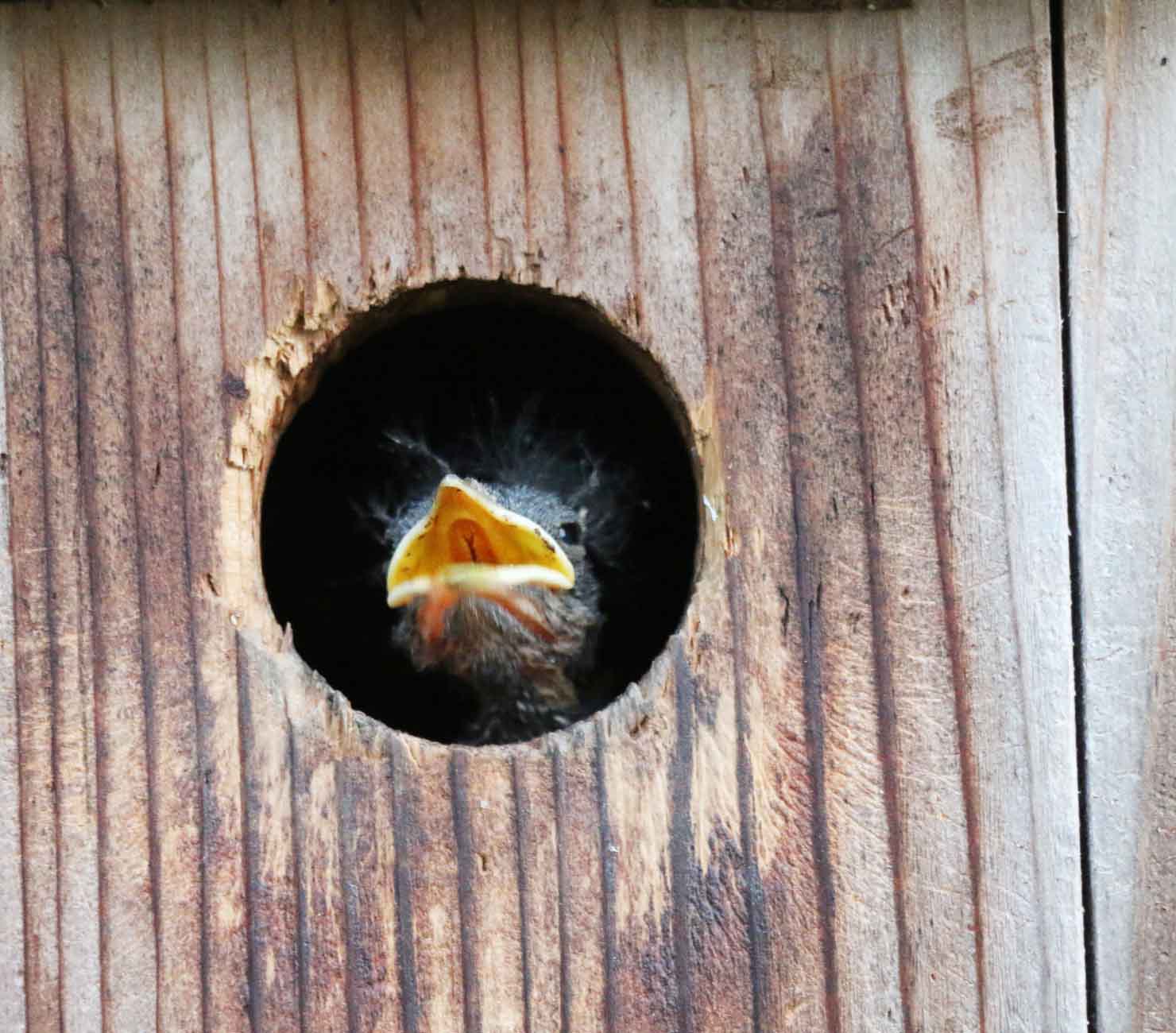Bluebird Baby Growth Stages
A nest of baby bluebirds will surely bring some joy to your late spring or summer birdwatching. But they could be grown and moved out before you know it, as bluebird baby growth stages move rapidly.
There are six distinct bluebird growth stages leading to adulthood. These are incubation, hatchling, nestling, fledgling, and juvenile. These stages typically span about six weeks, with the incubation stage being the longest (about two weeks).
This guide will help you identify and understand the different bluebird baby growth stages, ensuring that each moment spent observing your local bluebird nest is well-spent!

Week One: Initial Incubation
Like other birds, every bluebird starts its life as a fertilized egg.
After a bluebird couple successfully mates, the female bluebird lays a fertilized egg within about 24 hours. The couple will repeat this process for about a week, typically producing about five pale blue eggs, though some couples produce as many as seven or as few as three.
After this egg-laying period, the female bluebird will stay within the nest, ensuring that each laid egg is protected from predators and kept warm. This change in behavior kicks off the incubation stage, the longest of the bluebird baby growth stages.
While the female is incubating her eggs, the male bluebird will search for food and bring back meals to share with his mate. Remember, because birds are cold-blooded animals, their young develop outside of the parent's bodies.
As such, keeping the unhatched eggs warm is crucial to offspring development.
This initial incubation period can go awry if the female bluebird leaves the nest. For example, if her mate fails to bring back food, she may need to vacate the nest to feed, leaving her eggs undefended and allowing their temperature to go unmaintained.
Week Two: Final Incubation Stage
After the female bluebird has spent a week incubating her eggs, she can expect more of the same from the second week.
This final incubation stage is just as vital as the initial one, and male bluebirds must continue to bring back plenty of food to keep the female fed (and thus keep her within the nest). Significant temperature changes can halt the growth process of unhatched bird babies, leading to a longer-than-normal incubation period.
Still, if everything goes well, the unborn bluebirds will develop a sharp, pointed nodule on the end of their beak. This specialized equipment (often called an egg tooth) is what they use to break free of their eggs.
This emergence typically begins two weeks after the start of the initial incubation stage.

There's a lot more to Bluebird babies than just cute looks, there's tons of additional, fascinating things about them we write on in our fun Bluebird babies facts article here!
Week Three: Hatchling Stage
It can take hours for a baby bluebird to free itself from its eggy confines, but as soon as it has, it's officially a hatchling!
Notably, all of the eggs within a bluebird nest hatch within about a day or two of each other, so baby bluebirds tend to find themselves surrounded by identical-looking newborn birds in a short time.
These bluebird babies don't look very similar to their adult counterparts. They are generally featherless (except for a few dark patches on their heads) with orange-pink bodies and bright yellow beaks.
Because these baby birds are essentially naked, they rely on their mother, siblings, and the nest to remain warm. They also spend most of their time opening their wide yellow beaks to invite their parents to regurgitate food into their mouths.
This might not sound appetizing to us, but it's essential to baby bluebirds, as they cannot feed themselves during the hatchling stage. In fact, during the hatchling stage, baby bluebirds are essentially blind, helpless creatures.
Fortunately, that changes about a week after hatching.
Week Four: Nestling Stage
Four weeks after the bluebird eggs are laid, and about one week after they've hatched, the baby bluebirds enter the nestling stage.
During this stage, their bodies rapidly develop dark grey-blue patches of feathers, and these feathers keep the nestlings warm while their parents are away from the nest. They're also capable of opening their eyes and moving around the nest.
This stage is so-called because baby bluebirds nestle closely together, primarily spending their time eating, sleeping, or exploring the nest.
Unfortunately, this is also the stage where accidents can happen, as curious nestling bluebirds might fall out of the nest while stretching their wings and taking in the world around them.
Nestlings don't have the strength to fly long distances. Depending on how far along the baby bluebirds are during this stage, they might be unable to stop themselves from plummeting to the ground if they fall out of the nest.
But those that manage to stay safely nestled in the nest during this week of life will soon be ready to try flying and enter the fledgling stage.
Week Five: Fledgling Stage
By the third week of life outside the egg, baby bluebirds are ready to take to the skies and stretch their wings. These tiny bluebirds look far more like their parents, albeit a little plainer in coloration.
Fledgling bluebirds that don't immediately grasp the art of flying return to the nest to rest for a short while and then try again.
When a fledgling does manage to get the hang of things, they don't return to the nest, instead opting to stay within proximity while scouring the area for food. At this point, the baby bluebirds rely on their parents to point out food sources but are capable of feeding themselves.

All Bluebird babies come from eggs, yet bird eggs are an interesting topic in their own right. We think you'll find our article All About Bluebird Egg Facts to be a fascinating read, be sure to Check it out here!
Week Six: Juvenile
When a baby bluebird fritters away from the nest, becoming more independent and capable of feeding itself, it is still considered a fledgling.
Though these tiny birds aren't as dependent on their caretaker parents for food and warmth, they stay close to their parents and siblings as they grow and develop. This closeness is a survival tactic, allowing the young birds to nestle closely together at night for warmth and stick together when searching for food.
Baby bluebirds don't truly enter the juvenile stage until they've started growing their adult feathers. This process generally finishes during the autumn, during the height of migration season.
After growing out their plumage and migrating for the winter or staying put in warmer areas, the juvenile bluebirds are officially adults. These adult birds are sexually mature and capable of finding a mate, building a nest, and beginning the process of creating new baby bluebirds!
Bluebird Baby Growth Stages...Conclusion
Bluebird baby growth stages don't tend to last very long. Most baby bluebirds are ready to leave the nest less than a month after hatching. Still, it generally takes months for these juvenile birds to reach full maturity.
The incubation stage is the longest initial growth stage for baby bluebirds, lasting about two weeks. After the bluebird eggs hatch, the newly hatched bluebirds enjoy rapid physical growth before reaching the fledgling stage, at which point they're capable of leaving the nest.
In short, in only six weeks, bluebirds go from newly laid eggs (initial incubation) to independent creatures (juveniles).
Back To The TOP Of This Bluebird Baby Growth Stages Page

About the Author...
Richard Worden, a dedicated bird lover for over 20 years, I love to share my in-depth knowledge and passion for birds. Read more About Me and my expertise in this field.
- We Know Birds HOME ›
- Bluebird Facts and Information ›
- Bluebird Baby Growth Stages
